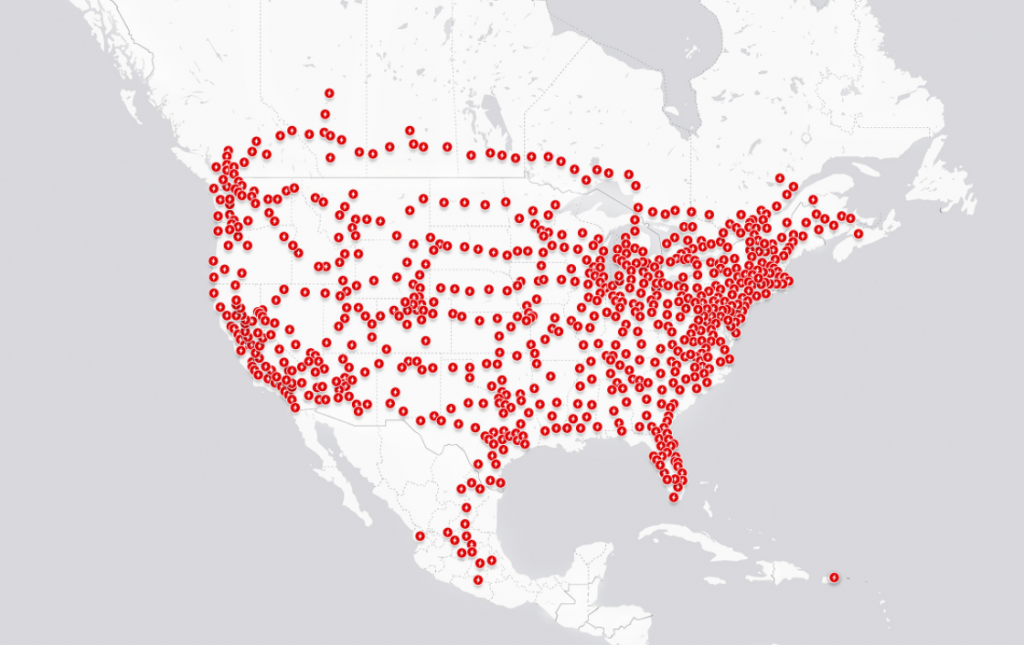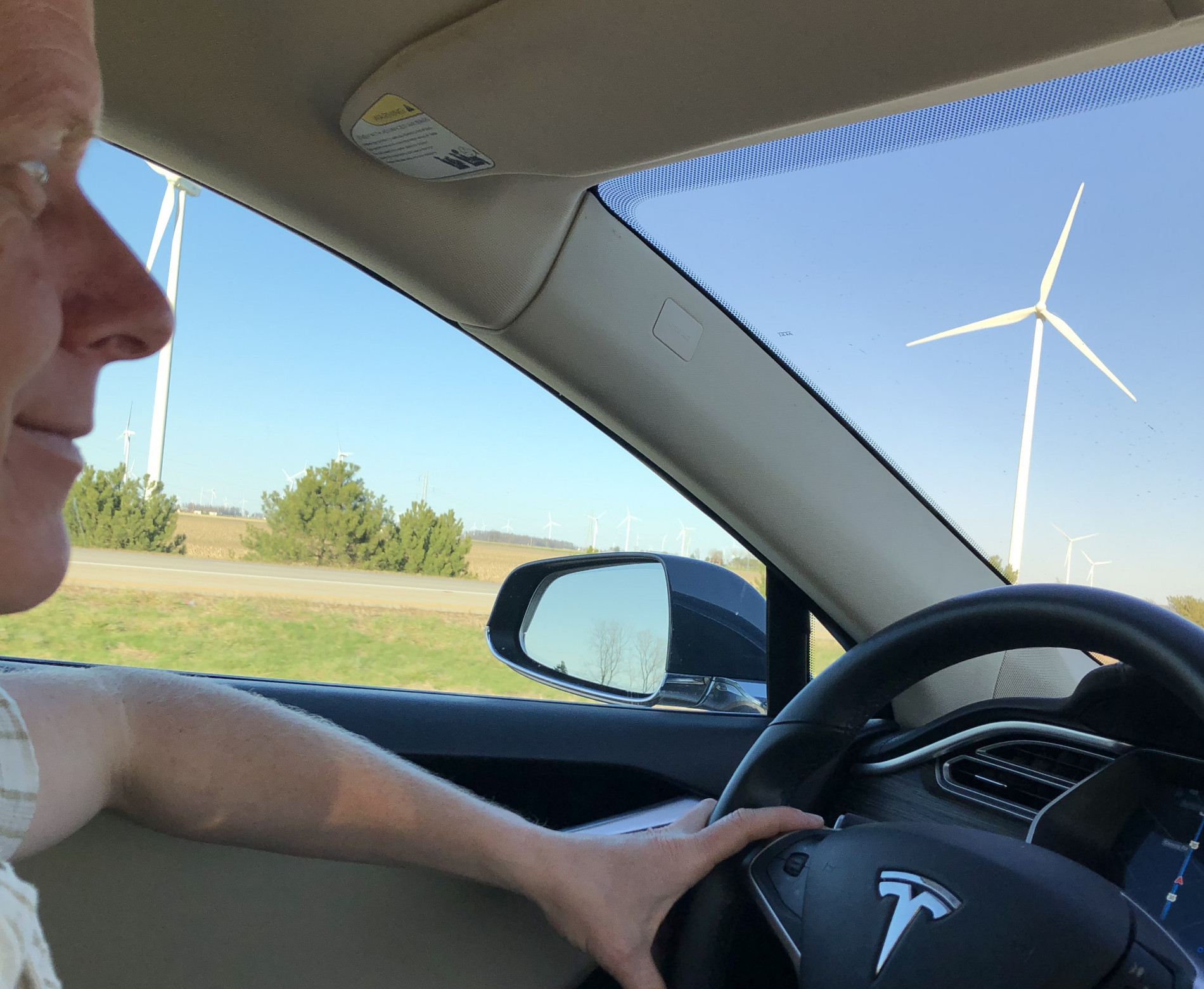Now that I’m talking more about our electric vehicle, I’m getting lots of really great questions from friends, acquaintances, and readers… thank you! I’ve compiled some of my favorite questions in this blog, but keep them coming! Post your questions in the comments box at the bottom of this post, message me on Facebook or Instagram or email me at carbonfreefamily@gmail.com.
Q: Does your Tesla use any gasoline?
Nope. Not one drop. How crazy is that?!?!
In fact, I find it fascinating to think about all of the pieces of a car associated with the gas engine that we don’t have…
Radiator? Nope.
Exhaust System? Nope.
Oil changes? Never have to do those.
Q: Do you have to drive out of your way to find a charging station?
Not necessarily. One of the reasons we bought a Tesla was for the amazingly designed charging network. There’s a super charger within 100 miles of just about every location in the United States. Check out the map below (from Tesla).
In fact, on our recent road trip from Michigan to North Carolina, we drove less miles following the route with charging stations that we would have otherwise (approximately 630 miles vs 690 miles). It took longer (see this blog post for a full recap of the trip), yes, but the miles driven were less.

Q: What mapping software do you use to map your route with charging stations?
From my phone or computer, I generally use A Better Route Planner. Once I’m in the car, Tesla has a pretty good mapping system built into the dashboard and I usually use that. In both of these mapping tools, I enter my destination and the route automatically includes one or more stops at charging stations along my route to ensure I’ll arrive at my destination safely. These directions are optimized for route and charge time… meaning that often I will stop for two shorter charges rather than one longer one because charging efficiency is highest when your battery is low (battery low = fast charging; battery nearly full = slower charging speed).
Q: What’s the difference between a supercharger and a destination charger?
Tesla Superchargers are 480-volt chargers that are designed to charge a Tesla in under an hour, making them perfect for charging up on long-distance road trips. They’ve generally been installed in a grid across the country, strategically placed on highly traveled routes/roads. These are installed and owned by Tesla, in partnership with various local businesses and towns.
Destination chargers, on the other hand, are installed by businesses and land owners for public use. They have a slower charging speed than Superchargers, adding about 35 or 40 miles of range per hour of charging. This blog has lots more information about the charging network if you’re interested in reading more. Destination chargers are being installed all over the country and are often designed to charge both Teslas and other brands of electric vehicles at the same charging station. It’s worth noting that if you want to charge your Tesla at a non-tesla branded charger, you do need to carry a converter with you because the plugs are shaped differently.

Q: How much does it cost to charge? Is it cheaper than gas?
Some places (usually slower chargers at a destination, like a museum, zoo, or business) are free, but the Tesla supercharging network we usually chose to use charges, on average $0.25 per kilowatt (kW). My Model S can drive approximately 3 miles per kW, which means I’m paying about $0.08 per mile.
When I charge at home, my cost to charge is even less, as I pay about $0.10 per kW for my electricity at home, which equates to about $0.03 per mile.
For reference, lets compare that to my previous car (an ’08 Honda Fit that got approximately 35 mpg) and assume the current gas price of $2.63 per gallon. I was paying about $0.13 per mile, so operating my Tesla (even if I always have to charge at the “expensive” supercharging stations) is cheaper than operating my old gas engine car.
Now, my Honda Fit cost me approximately $17,000 to buy in 2008 and I paid about $50,000 for my used Tesla in 2020, so I’ll have to drive 660,000 miles before I make up the difference in purchase price. There are additional cost savings in maintenance (for example, I never have to change my oil). This blog estimates the average maintenance at around $300 per year.
Q: Electricity is made by burning fossil fuels, so how is an electric car better for the environment?
You’re right that lots of the electricity in the United States is made by coal burning power plants. According to the US Energy Information Administration (eia) about 60% of electricity generated in the US in 2020 was from fossil fuels—coal, natural gas, petroleum, and other gases. About 20% was from nuclear energy, and about 20% was from renewable energy sources.
At home, we purchase 100% renewable energy credits. While it’s impossible to received the exact kW generated from solar and wind because it all gets mixed together in the grid, when I choose to pay an extra $1.50 per 150 kWh, I’m encouraging Consumers Energy, our electricity provider, to invest in more renewables and helping to fund these projects. You can do this too, by joining the Solar Gardens program. Subscription levels start at $9 per month and help fund solar panel projects throughout the state.
Whether you have an electric car or not, I encourage you to contact your electricity provider and ask about their renewable energy programs. Programs throughout the country are all structured a little differently, but nearly every electricity company has one. And if yours doesn’t, keep pestering them until they create one. As their customer, you hold all the power (pun intended)!

Do you have a question I didn’t answer yet?? Post your questions in the comments box below, message me on Facebook or Instagram or email me at carbonfreefamily@gmail.com.
